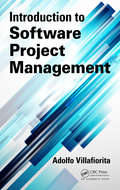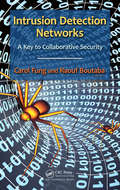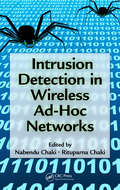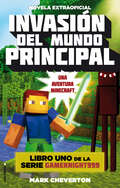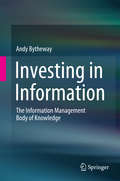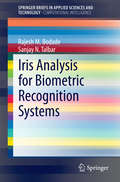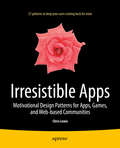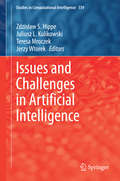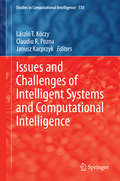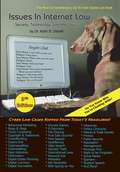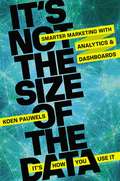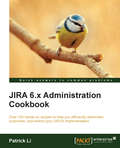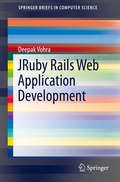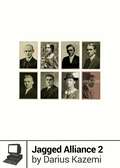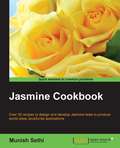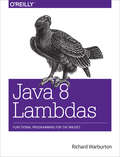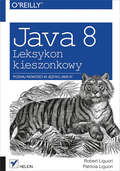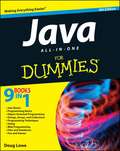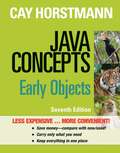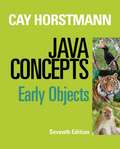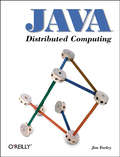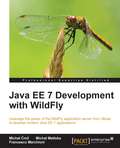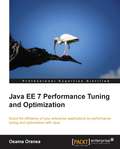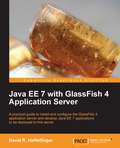- Table View
- List View
Introduction to Software Project Management
by Adolfo VillafioritaAlthough software development is one of the most complex activities carried out by man, sound development processes and proper project management can help ensure your software projects are delivered on time and under budget. Providing the know-how to manage software projects effectively, Introduction to Software Project Management supplies an acces
Intrusion Detection Networks: A Key to Collaborative Security
by Raouf Boutaba Carol FungThe rapidly increasing sophistication of cyber intrusions makes them nearly impossible to detect without the use of a collaborative intrusion detection network (IDN). Using overlay networks that allow an intrusion detection system (IDS) to exchange information, IDNs can dramatically improve your overall intrusion detection accuracy.Intrusion Detect
Intrusion Detection in Wireless Ad-Hoc Networks
by Nabendu Chaki Rituparna ChakiPresenting cutting-edge research, Intrusion Detection in Wireless Ad-Hoc Networks explores the security aspects of the basic categories of wireless ad-hoc networks and related application areas. Focusing on intrusion detection systems (IDSs), it explains how to establish security solutions for the range of wireless networks, including mobile ad-hoc
Invasión del mundo principal: Una aventura Minecraft (Gameknight999 #Volumen 1)
by Mark ChevertonA Gameknight999 le mola Minecraft, pero por encima de todo le gusta grifear y arruinar la partida a otros jugadores. -Novela extraoficial- Cuando uno de los inventos creados por su padre le teletransporta dentro de Minecraft, Gameknight se encuentra con una aventura real en medio de un mundo digital. ¿Qué pasaría si le mataran? ¿Moriría en la vida real?Metido en el juego, Gameknight descubre el secreto mejor guardado de Minecraft, algo de lo que aún no se han dado cuenta ni los programadores del juego: ¡las criaturas que allí habitan están verdaderamente vivas! Evitando ser atrapado por las garras afiladas de los zombis y los puntiagudos colmillos de las arañas, Gameknight deberá aprender a hacer amigos y a entender la importancia del trabajo en equipo para poder sobrevivir a la guerra Minecraft que acaba de comenzar. La crítica ha dicho...«Estas aventuras adictivas encantarán a los fans Minecraft y les llenará de valor y coraje al igual que cuando juegan delante de la pantalla.»Parents in Touch«Este libro nos enseña un mensaje muy claro, que hay libros que pueden leer tanto niños como adultos de todo el mundo. Muy recomendable y entretenido.»Midwest Book Review
Investing in Information
by Andy BythewayThis book gathers together, in a new way, established and contemporary thinking about how to get the best out of information technology and information systems investments. Working managers who are beset by the complexities of information management in the age of Big Data and the Social Web, and students who are trying to make sense of information management in a chaotic world that is more and more driven by the Internet, will all benefit from this new treatment of a long-standing and problematic domain. Importantly, the book reveals and clarifies the dependencies that exist between the inner world of information technology and the outer world of people and organisations at work. The book differs from other books in its reflective approach. It avoids lengthy, descriptive, and prescriptive dogma. Rather, it provides tools for thinking about information management and it identifies strategic and tactical options at six levels: from the simple consideration of information technology and information systems, right through to issues of organisational performance and business strategy. At the heart of the matter are two critical and tightly connected issues: the ways that we conceive and manage an organisation's processes, and the ways that we conceive and manage the information that an organisation needs to sustain those processes. The six-level framework that achieves this clarity is the "Information Management Body of Knowledge" (familiarly known as the "IMBOK"). This easy-to-understand and easy-to-remember framework has been found to be extremely useful in business, in government, in civil society and in education. Throughout the book, selected research papers are identified and summarised. There are also summary chapters from three different operational perspectives: performance and competency assessment using the IMBOK, undertaking research into related issues, and a review of parallel expert thinking. This book stands as a reference point and resource for all those who need to straddle the disparate worlds of "information technology" and "business". It provides firm pedagogical foundations for courses dealing with business management in the information age, and it provides a sound reference framework for researchers who need to position research projects related to information technology and information systems in a wider context. For busy managers, who simply wish to identify, understand and successfully manage information technology-related opportunities, it provides an ideal arrangement of ideas and tools that will help them.
Iris Analysis for Biometric Recognition Systems
by Rajesh M. Bodade Sanjay N. TalbarThe book presents three most significant areas in Biometrics and Pattern Recognition. A step-by-step approach for design and implementation of Dual Tree Complex Wavelet Transform (DTCWT) plus Rotated Complex Wavelet Filters (RCWF) is discussed in detail. In addition to the above, the book provides detailed analysis of iris images and two methods of iris segmentation. It also discusses simplified study of some subspace-based methods and distance measures for iris recognition backed by empirical studies and statistical success verifications.
Irresistible Apps
by Chris LewisThis practical guide provides a comprehensive overview of professionally managed assets, or investments in which all portfolio decisions and rebalancing are delegated to a fund manager or third-party advice service. Savvy investors looking to achieve a better understanding of the nuances, benefits, and drawbacks of using these products?will find the answers they are looking for in?The Handbook of Professionally Managed Assets, ?no matter whether they would like to learn more about mutual funds or hedge funds. There is a considerable lack of knowledge among the investing public about how to properly construct a well-diversified portfolio of investments that includes a selection of professionally managed assets. As a long-standing financial planner, attorney, and educator, Keith Fevurly remedies this issue in The Handbook of Professionally Managed Assets?by clearly presenting the major categories of professionally managed assets and revealing the best tactics for investing in these vehicles. Along the way, he reveals each asset''s risks and rewards, and he also provides the in-depth knowledge and information investors need to confidently select the right assets for their portfolios. Filled with valuable insights for everyone from financial professionals to individual investors, The Handbook of Professionally Managed Assets?stands alone in its ability to shed light on the many investment vehicles that fall under the larger umbrella of professionally managed assets. With topics as wide-ranging as mutual funds, closed-end funds, unit investment trusts, exchange traded funds, hedge funds, managed futures, and more, this invaluable resource will give you the information you need to build a prosperous financial future for yourself and your clients.
Issues and Challenges in Artificial Intelligence
by Zdzisław S. Hippe Juliusz L. Kulikowski Teresa Mroczek Jerzy WtorekThe importance of human-computer system interaction problems is increasing due to the growing expectations of users on general computer systems capabilities in human work and life facilitation. Users expect system which is not only a passive tool in human hands but rather an active partner equipped with a sort of artificial intelligence, having access to large information resources, being able to adapt its behavior to the human requirements and to collaborate with the human users. This book collects examples of recent human-computer system solutions. The content of the book is divided into three parts. Part I is devoted to detection, recognition and reasoning in different circumstances and applications. Problems associated with data modeling, acquisition and mining are presented by papers collected in part II and part III is devoted to Optimization.
Issues and Challenges of Intelligent Systems and Computational Intelligence
by Janusz Kacprzyk László T. Kóczy Claudiu R. PoznaThis carefully edited book contains contributions of prominent and active researchers and scholars in the broadly perceived area of intelligent systems. The book is unique both with respect to the width of coverage of tools and techniques, and to the variety of problems that could be solved by the tools and techniques presented. The editors have been able to gather a very good collection of relevant and original papers by prominent representatives of many areas, relevant both to the theory and practice of intelligent systems, artificial intelligence, computational intelligence, soft computing, and the like. The contributions have been divided into 7 parts presenting first more fundamental and theoretical contributions, and then applications in relevant areas.
Issues in Internet Law: Society, Technology, and the Law (Ninth Edition)
by Keith B. DarrellThis book provides a concise overview of Internet law updated with the latest cases and trends.
It's Not the Size of the Data - It's How You Use It: Smarter Marketing with Analytics and Dashboards
by Koen PauwelsBrand tracking, CRM programs, trade shows, online behavior tracking, satisfaction studies. Mounds of marketing metrics are generated across touchpoints and channels. It can be information overload--too much, too scattered. But locked in the vast quantity of information are accurate, data-driven answers to every marketing question. Analytic dashboards are transformative web-based tools that gather, syn the size, and visually display essential data in real time, directly connecting marketing with performance. World renowned marketing expert Koen Pauwels supplies a simple yet rigorous methodology and wealth of case studies to help any size organization, in any industry, turn data into productive action. He explains step by step how to: Gain crucial IT support Build a rock-solid database Select key leading performance indicators Design the optimal dashboard layout Use marketing analytics to improve decisions and reap rewards Gut decisions are outdated and downright dangerous. Whether you're trying to allocate resources between online and offline marketing, measure the ROI of specific efforts, or scale up a creative campaign, dashboard analytics bring scientific precision and insight to marketing efforts--with far better results.
JIRA 6.x Administration Cookbook
by Patrick LiA comprehensive guide, full of practical recipes with real-life JIRA administration challenges, solutions, and examples with illustrations from the actual application. If you are an administrator who will be customizing, supporting, and maintaining JIRA for your organization, this book is for you. Familiarity with the core concepts of JIRA is essential. For some recipes, basic understanding in HTML, CSS, and JavaScript will also be helpful.
JMeter Cookbook
by Bayo ErinleThis book is great for you if you are a developer, quality assurance engineer, tester, or test manager who is looking to get a firmer grasp of elementary, deep, and advanced testing concepts using Apache JMeter. It's assumed you have access to a computer and an Internet connection. No prior testing or programming experience is required, but would be helpful.
JRuby Rails Web Application Development
by Deepak VohraThis SpringerBrief explains how to create a Rails web application with JRuby, a 100% Java implementation for Ruby. This brief demonstrates how Oracle® WebLogic servers and JBoss® application servers deploy the JRuby application, how JRuby runs on the Java® Virtual Machine, and how JRuby is the basis for popular websites including LinkedIn, Oracle Mix, and Mingle. The Oracle® database and Oracle® MySQL database are used as the basis for the JRuby Rails application. Chapters also cover enabling Flash, developing the JRuby application using Ruby syntax, and deploying applications through Java EE WAR. Hands-on and practical, this SpringerBrief is designed for web developers and researchers interested in JRuby. It is also a useful guide for advanced-level students interested in creating a new web application.
Jagged Alliance 2 (Boss Fight Books)
by Darius KazemiThe turn-based tactical role playing series Jagged Alliance has been sequeled, expanded, modded, optioned, multiplayered, and kickstarted, but the series' many fans usually point to Jagged Alliance 2 as the high water mark, and one of the finest turn-based video games of all time. Jagged Alliance 2 brings to the table a wicked sense of humor, simulation-driven character design, a combination of strategic overworld and tactical battles reminiscent of the X-COM series, and a surprisingly deep open-world RPG experience reminiscent of the Ultima or Elder Scrolls games. Focusing on JA2's development history and basing his book largely on new personal internviews with the game's developers, game designer and web technology developer Darius Kazemi delves deep into the legacy of a game that still has much to teach gamers and game-makers 14 years after its release.
Jasmine Cookbook
by Munish SethiIf you are a competent JavaScript developer who wants to design and implement tests using Jasmine in order to minimize bugs in the production environment, then this book is ideal for you. Some familiarity with unit testing and code coverage concepts such as branch coverage along with basic knowledge of Node.js, AngularJS, and CoffeeScript is required.
Java 8 Lambdas: Pragmatic Functional Programming
by Richard WarburtonIf you’re a developer with core Java SE skills, this hands-on book takes you through the language changes in Java 8 triggered by the addition of lambda expressions. You’ll learn through code examples, exercises, and fluid explanations how these anonymous functions will help you write simple, clean, library-level code that solves business problems.Lambda expressions are a fairly simple change to Java, and the first part of the book shows you how to use them properly. Later chapters show you how lambda functions help you improve performance with parallelism, write simpler concurrent code, and model your domain more accurately, including building better DSLs.Use exercises in each chapter to help you master lambda expressions in Java 8 quicklyExplore streams, advanced collections, and other Java 8 library improvementsLeverage multicore CPUs and improve performance with data parallelismUse techniques to “lambdify” your existing codebase or library codeLearn practical solutions for lambda expression unit testing and debuggingImplement SOLID principles of object-oriented programming with lambdasWrite concurrent applications that efficiently perform message passing and non-blocking I/O
Java 8. Leksykon kieszonkowy
by Patricia Liguori Robert Liguori??Java jest dzi? j?zykiem, który programi?ci wybieraj? najcz??ciej, gdy maj? przed sob? skomplikowany projekt, wymagaj?cy najwy?szej wydajno?ci, jako?ci, bezpiecze?stwa oraz integracji z innymi systemami. Rozwijany od blisko dwudziestolecia, j?zyk ten doczeka? si? wersji oznaczonej numerem 8. Ta edycja zosta?a wzbogacona o wiele nowo?ci, m.in. o d?ugo oczekiwane wyra?enia lambda. Je?eli szukasz por?cznej ksi??ki, do której mo?esz si?gn?? w przypadku w?tpliwo?ci, to trafi?e? na doskona?? pozycj?!Ta publikacja nale?y do popularnej serii „Leksykon kieszonkowy” i mo?esz mie? j? zawsze przy sobie. W ?rodku znajdziesz konwencje nazw oraz podstawowe elementy j?zyka. W kolejnych rozdzia?ach zdob?dziesz wiedz? na temat typów prostych oraz programowania zorientowanego obiektowo. Ponadto zawarto tu przyst?pne omówienie wyra?e? lambda, wspó?bie?no?ci oraz zasad dost?pu do plików i sieci. Java posiada rozbudowany mechanizm obs?ugi sytuacji wyj?tkowych, który równie? zosta? omówiony w tym podr?czniku. Ksi??ka ta jest obowi?zkow? pozycj? na pó?ce ka?dego programisty j?zyka Javy — je?li chce on mie? zawsze pod r?k? wiarygodne ?ród?o informacji na temat tego j?zyka.Dzi?ki tej ksi??ce:- poznasz elementy i sk?adni? j?zyka Java- zrozumiesz zasad? dzia?ania wyra?e? lambda- wykorzystasz nowe metody dost?pu do plików- zaznajomisz si? z nowo?ciami w Javie 8- b?dziesz mie? zawsze pod r?k? solidne ?ród?o wiedzyTwój przewodnik po j?zyku Java!
Java All-in-One For Dummies
by LoweEverything you need to get going with Java!Java All-in-One For Dummies, 4th Edition has what you need to get up and running quickly with Java. Covering the enhanced mobile development and syntax features as well as programming improvements, this guide makes it easy to find what you want and put it to use. Focuses on the vital information that enables you to get up and running quickly with Java Covers the enhanced multimedia features as well as programming enhancements, Java and XML, Swing, server-side Java, Eclipse, and more Minibooks cover Java basics; programming basics; strings, arrays, and collections; programming techniques; Swing; Web programming; files and databases; and a "fun and games" categoryJava All-in-One For Dummies, 4th Edition focuses on the practical information you need to become productive with Java right away.
Java Concepts (Seventh Edition)
by Cay S. HorstmannCay Horstmann's seventh edition of Java Concepts provides an approachable introduction to fundamental programming techniques and design skills, helping students master basic concepts and become competent coders. Major rewrites and an updated visual design make this student-friendly text even more engaging. The text is known for its realistic programming examples, great quantity and variety of homework assignments, and lab exercises that build student problem-solving abilities. The seventh edition now includes problem solving sections, more example code online, and exercises from Science and Business.
Java Concepts: Early Objects
by Cay S. HorstmannIn Java Concepts, Cay Horstmann provides a comprehensive introduction to fundamental programming techniques and design skills helping the student master basic concepts. Realistic programming examples, homework assignments, and lab exercises build student problem-solving abilities.
Java Distributed Computing (Java Series)
by Jim FarleyDistributed computing and Java go together naturally. As the first language designed from the bottom up with networking in mind, Java makes it very easy for computers to cooperate. Even the simplest applet running in a browser is a distributed application, if you think about it. The client running the browser downloads and executes code that is delivered by some other system. But even this simple applet wouldn't be possible without Java's guarantees of portability and security: the applet can run on any platform, and can't sabotage its host.Of course, when we think of distributed computing, we usually think of applications more complex than a client and server communicating with the same protocol. We usually think in terms of programs that make remote procedure calls, access remote databases, and collaborate with others to produce a single result. Java Distributed Computing discusses how to design and write such applications. It covers Java's RMI (Remote Method Invocation) facility and CORBA, but it doesn't stop there; it tells you how to design your own protocols to build message passing systems and discusses how to use Java's security facilities, how to write multithreaded servers, and more. It pays special attention to distributed data systems, collaboration, and applications that have high bandwidth requirements.In the future, distributed computing can only become more important.Java Distributed Computing provides a broad introduction to the problems you'll face and the solutions you'll find as you write distributed computing applications.Topics covered in Java Distributed Computing:Introduction to Distributed ComputingNetworking BasicsDistributed Objects (Overview of CORBA and RMI)ThreadsSecurityMessage Passing SystemsDistributed Data Systems (Databases)Bandwidth Limited ApplicationsCollaborative Systems
Java EE 7 Development with WildFly
by Michal Matloka Michal CmilIf you are a Java developer who wants to learn about Java EE, this is the book for you. It's also ideal for developers who already have experience with the Java EE platform but would like to learn more about the new Java EE 7 features by analyzing fully functional sample applications using the new application server WildFly.
Java EE 7 Performance Tuning and Optimization
by Osama OransaThe book adopts a step-by-step approach, starting from building the basics and adding to it gradually by using different tools and examples. The book sequence is easy to follow and all topics are fully illustrated showing you how to make good use of different performance diagnostic tools. If you are an experienced Java developer, architect, team leader, consultant, support engineer, or anyone else who needs performance tuning in your Java applications, and in particular, Java enterprise applications, this book is for you. No prior experience of performance tuning is required.
Java EE 7 with GlassFish 4 Application Server
by David R. HeffelfingerThis book is a practical guide and follows a very user-friendly approach. The book aims to get the reader up to speed in Java EE 7 development. All major Java EE 7 APIs and the details of the GlassFish 4 server are covered followed by examples of their use. If you are a Java developers who wants to become proficient with Java EE 7 this book is ideal for you. Readers are expected to have some experience with Java and to have developed and deployed applications in the past, but don’t need any previous knowledge of Java EE or J2EE. It teaches the reader how to use GlassFish 4 to develop and deploy applications.
